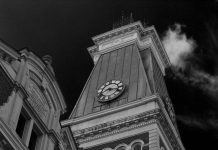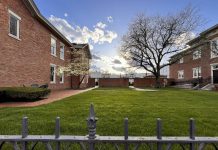•two small basement rooms at the Bartholomew County Public Library, social media coordinator Curtis Hartwell is painting over the existing black that has covered the walls for decades. In his new vision for the space, one wall will be painted with graffiti artwork; another will be a vibrant lime green.
Originally, this area served as a dedicated projector room for the library’s Red Room, where many special events are conducted. After a makeover and the installation of new digital equipment, these projector rooms will become Columbus’ first — and one of Indiana’s only — digital maker space that will be known as the Digital Underground.
“I’ve always wanted to have a maker space here,” Hartwell said. “Just as a way to attract a different audience. I was trying to figure out a way that this space would work well with this town, this community. We are sort of a design-based community. So I thought this is the best way to offer a space that focused on art and being creative.”
Bouncing off his own predilection for digitally produced pieces, Hartwell began envisioning the Digital Underground project about a year ago.
[sc:text-divider text-divider-title=”Story continues below gallery” ]
Hartwell has become known locally through a series of videos for the library, including the “Do or DIY Trying” series. Most of the videos are shot in the library in front of a green screen — a lime green piece of fabric that Hartwell irons before each shoot. In production, Hartwell stitches in goofy effects, turning the green screen into the backdrop for MTV’s ’90s and early ’00s show “Total Request Live” or suturing into a video a cameo by television magician Criss Angel.
A maker space is an area that is open to anyone who wants to create. They are often based on the visual arts, with painting supplies and access to fabrication equipment.
The Digital Underground will occupy the two rooms opposite the Columbus Indiana Architectural Archives. Featuring five computers — in a melange of PCs and Apple Macs — the space will offer patrons access to:
Assorted creative software, including Adobe Creative Suite.
3D graphics programs such as Blender and Google SketchUp Pro.
Music production software such as Audacity, LMMS and Logic Pro X.
Want to record your album? Digital Underground will feature a recording studio in which musicians can plug their instruments directly into a USB interface to override any amps for a host of effects and filters.
Want to create a video? At Digital Underground, you’ll find a green screen, cameras, lights; all you provide is the action.
At some point, Hartwell hopes to throw a 3D printer into the mix.
The cutting-edge programs put potential digital makers in line with current technologies. It should also put Digital Underground patrons right in line with trends in art production.
USING THE SPACE
“From my personal experiences with architecture and journalism, digital art is the latest way to express (yourself),” Columbus North High School senior Lillyanne Pham said. “It is crisp, clean and efficient. The possibles are overwhelming in a good way. Teenagers always need an outlet to express themselves, and many are hindered by financial issues. Curtis’ project will allow them to explore without the obstacle of expenses.”
The space stemmed from a conversation Hartwell had last spring that involved art.
“It got me on the trail of thought that we don’t really have anything for people to access specific equipment in an open space,” he said.
Library higher-ups green-lit the idea, and began bouncing thoughts around.
“Lots of libraries have maker spaces,” library director Beth Booth Poor said. “We realized digital art was something we don’t have a lot of venues for here.”
Hartwell visited other digital maker spaces. Bloomington has one that is open to the community, and Allen County’s public library has the TekVenture maker space, housed in a trailer in the library parking lot.
Success stories come of these spaces, even in the Midwest. Chance the Rapper, now a success on the hip-hop scene, was born of a digital maker space in Chicago, Hartwell said.
“We want to provide a place for people to create,” library assistant director Jason Hatton said. “It’s not just to consume information, but to create.”
In outfitting the space with new computers, software, furniture and other equipment, Hatton said the library’s expenses were less than $10,000.
“I think it’s a pretty reasonable cost,” Hatton said. “The library strives to be a place that has the resources available that people want.”
The space will open sometime after an April 10 regional library conference. It’s a date that serves as the Bartholomew County Public Library’s deadline for finishing the project, which is being championed by community leaders.
Once open to the public, patrons can access the Digital Underground with a library card.
Cindy Frey, who calls herself a “cheerleader” of the Digital Underground project, said the new maker space dovetails nicely with assorted community conversations about fostering this “culture of doing” in Columbus residents.
“When we have a community of doers, you have people who are creating and inventing,” Frey said. “I think that all plays into a community being more entrepreneurial.”
The space, Hartwell said, is for the maker, the tinkerer, the creator. It’s for the person who doesn’t have the cash to throw at a brand-new digital camera or Adobe Creative Suite. It’s for someone like Pham.
“At North, you can only access the Adobe Suite Software and 3D printing if you take classes involving it,” Frey said. “Numerous students don’t even know those programs exist, and I think that’s unfortunate. Moreover, you can only use those programs within school and not for your own personal use. This means you would have to pay for the program, which is expensive if you don’t have an IU or IvyTech discount or connection.”
For now, Hartwell continues to paint the space. Soon, the old carpet will come up and a sleek new floor will go in.
The space’s aesthetic has to be just right, he said. After all, if the Digital Underground looks just like an office, no one will come. Once the setup is finished, it’s up to patrons to come and use it.
“It’s not just a room for technology,” Hartwell said. “It’s about engaging the community as well. I think that’s just as important.”




